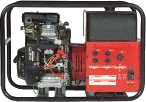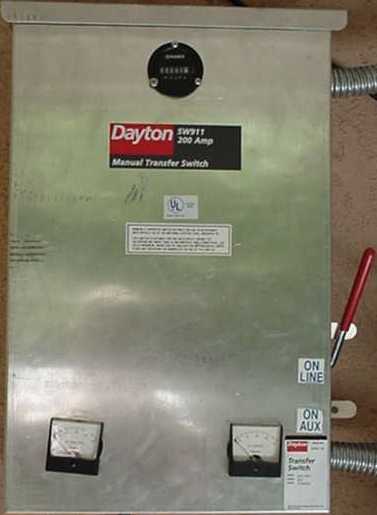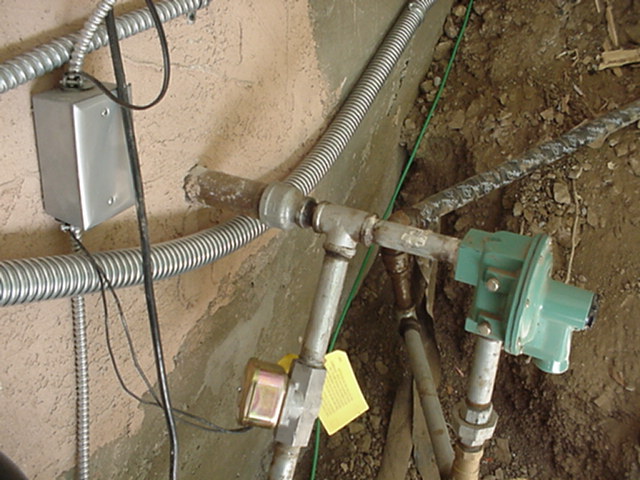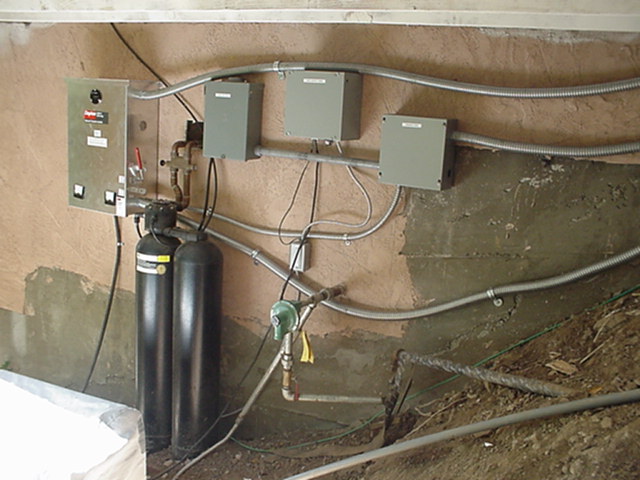
Last modification: 01/19/08 19:26

Going "off the grid" means making your own electricity. When we moved into rural Cupertino, it seemed like a good idea - neighbors were telling us we could expect power outages "3-4 times a year", and one particular outage "lasted a couple weeks." Folks living in the Santa Cruz mountains went a whole month without power when last December's storms took out thousands of homes along Highway 9. We thought it would be prudent planning to wire the house up with a generator, and when you're already pumping your own water and heating with propane, why not?
What we didn't know was that a few months later California was introduced to the "rotating blackout" concept. Long before we actually lost power due to the storms, we'd already given the generator a workout thanks to the power crisis. Of course, this is the type of thing that makes survivalists wring their hands in glee; being the only home with the power on! In our area though, it seemed like everyone else had done the same thing.
Generators can be noisy, smelly things to run and I really didn't want to deal with feeding an oversized lawnmower engine gas and oil and running the tank empty between outages. But when there's a propane tank already staring at you, the solution is clear: get a multifuel generator. We put ours underneath the deck on a concrete slab and grounded it.

The Winco HPS9000E Tri-Fuel
The Winco model above seemed the choice, although the number of models actually suitable for home power applications are few and you see some models over and over. That's the case on our road, where all the homes with permanent generator installations are running this particular unit. What makes it suitable is its price, (under $2K) power (9KW) and multiple fuel source options - you can configure it for gasoline, propane or natural gas. You do take a small efficiency hit when not running off gasoline, particularly at higher elevations - but it runs cleanly and does the job. Note however, that we're not saving any money here - at about one gallon of propane per hour, it's a more expensive source of power than PG&E.
Due to the sheer cost, we decided early on to go with a manual transfer switch. In fact, the cheapest solution of all is to tie your generator into the main panel or a sub-panel along with a couple pairs of breakers to take it (and PG&E) on and off-line. Unfortunately, the cheap solution is a dangerous one - throw the breakers in the wrong order and you could zap the generator (bad) or fry a PG&E lineman (very bad.)
A real manual transfer switch automates the task of disconnecting the PG&E when the generator is running, and vice-versa; you only have to throw a single lever and there's no way to get it wrong. The inexpensive units you may find at places like Costco are designed for controlling only a few circuits in your house and that's it. Now, the current that the Winco puts out will typically be under 30 amps, not much more than a single typical 20A house circuit; but as you're unlikely to be drawing more than a dribble from any one circuit at a given time, why not just power the whole house?
Well, two reasons. First, if you power your whole house off the generator, than you have no way of knowing when the PG&E has come back on. For this, we installed a relay-controlled beacon light on the side of the house that works like this: When the generator is running, the generator closes a relay on a dedicated PG&E branch circuit exclusively for the benefit of the beacon. If the beacon blinks, then it's time to kill the generator and go back on-line.
The second is the cost of a transfer switch big enough to switch the entire house between the 30A generator and the 200A PG&E mains we have. For that we needed a transfer switch of commercial proportions, of which the only choice was the Dayton model below. Believe me, $600 is a hell of a lot to spend on something that's little more than an empty box with a giant lever, but it's actually cheap compared to some other switches of this size. PG&E gives this type of mechanism an offical blessing on their Generator Safety page, which is must reading.

Dayton 9281 Commercial Manual Transfer Switch
When the power went out last winter, we'd already proven to ourselves that the Winco could handle the home heating blowers, which are our biggest load aside from cooking. But there is a limit, and we wanted to know how much of the generator's capacity we were using at any one time. Winco resells a little line voltage monitor that we leave plugged into our kitchen outlet; it's actually a Tempo product part # 280110/Model # LVM110. If the house voltage starts to sag below about 115V, we need to turn off some items. Fortunately the only time this became an issue was when we were deliberately stress-testing the system by turning on our electric cooking appliances and seeing how much we could get away with. In reality, we'd probably limit our generator-powered cooking to the toaster oven or microwave but running two burners on the stovetop was OK.
While handy, a plug-in voltage meter does not paint a complete picture of house power consumption. The fact is, that the 240V coming out of the generator is better thought of as two 120V "legs", A and B. Some circuits in the house are going to be running off the A leg, and others off the B. 240V appliances will be running off both. If you want to avoid undue strain on your generator, you should try and balance the power consumption across each leg. We monitor this with a Simpson 50A ammeter on each leg of the auxiliary power and added a Cramer AC hour meter so we'd know when to change the generator oil. We placed these directly on the cover of the Dayton transfer switch, which has plenty of room given that it's mostly an empty box. You can see the two ammeters on the bottom and the round hour meter on top.

Transfer switch with meters installed
Now up to this point, we'd been using a manual lever to turn the gas on and off. If the generator stalled, there'd be a potential gas leak near the generator. At best, we'd be losing propane - and at worst, the house! What we needed was a way for the gas line to automatically shut itself off when the generator isn't running, a common enough scenario that Winco has a kit for it. The kit contains three parts: A ¾” 12 volt DC vapor fuel solenoid (WINCO part number 42942-000), a 120 volt AC single pole relay (SPDT) (WINCO part number 59944-001) and a push-button switch to override the relay when you're manually starting the generator. Not provided here is the transformer and rectifier we used to provide 12V power from the generator to the relay.

Gas solenoid (next to the yellow tag)
Was there an easier way to go than this? Some folks might prefer going the fully-automatic route. New units from Coleman, Generac and Winco provide turn-key kits to do everything I just described short of the amp meters, with the added bonus of enclosing the generator in a heavy, sound-dampening case. You will pay a couple thousand dollars extra for the convenience, but the automatic transfer switch included (at least with the Coleman and Generac units) is only 100A. If your PG&E mains satisfy this requirement, then you've got a win - otherwise you'll just be throwing the automatic transfer switch away if your goal is to power the whole house.
With an automatic transfer unit, your going to experience some downtime - even if it's only the 20 seconds it takes to start the generator and stabilize. For that reason we have UPS'es on mission-critical things like the home network. Generator power is dirty, though - and for that reason, make sure you pick units whose trigger sensitivity is adjustable (or simply compatible.) We've gotten good results using an APC Smart-UPS 1400 on the server computer and Belkin 650VA Regulator Pro Golds everywhere else. Both units have automatic voltage regulation and come with sophisticated computer monitoring software. The APC, which covers more sensitive gear than elsewhere in the house, is a pure sine-wave device. APC could learn a few things from Belkin, however - their software is much nicer to use.
And that's the story. I hope that you found all this useful, particularly if you too decide to bite the bullet and go off the grid too. If you decide to reproduce any parts of this setup, I've provided links to most of the items we used. If you have any questions or comments, please send me an email.

The completed project (Winco under cover in lower left)